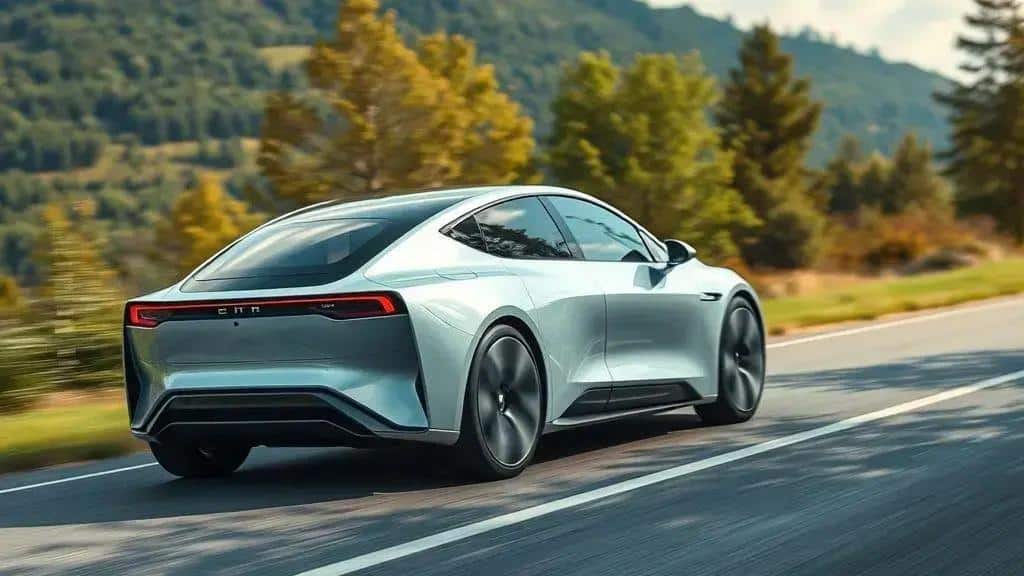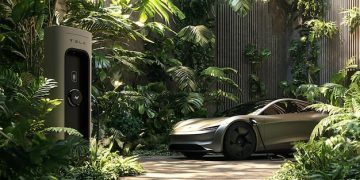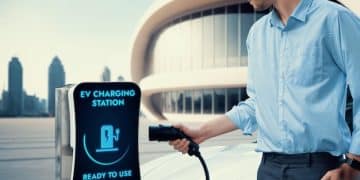Experts discuss how sustainability is driving innovation

Sustainability in the auto industry drives innovation through consumer demand for eco-friendly solutions, with leading brands like Tesla and BMW adopting advanced technologies and practices to reduce environmental impact.
Experts discuss how sustainability is driving innovation in the auto industry, reshaping how we think about transportation. Have you noticed how electric vehicles and green technologies are changing our roads? Let’s delve into these exciting trends.
The future of sustainability in the auto industry
The future of sustainability in the auto industry is bright and full of promise. As automakers face increasing pressure to reduce their environmental impact, many are investing in new technologies and strategies. This shift is not just about compliance; it’s about innovation and creating a better world.
The role of renewable energy
One major trend is the growing use of renewable energy sources. Companies are now focusing on:
- Solar power for manufacturing plants.
- Electric vehicles (EVs) charged with wind energy.
- Investments in energy-efficient production techniques.
This move towards renewables helps to lower carbon footprints and supports a greener economy.
Advancements in electric vehicles
Electric vehicles are at the forefront of the sustainability movement. With advancements in battery technology, EVs are becoming more efficient and accessible. Improvements have led to:
- Longer ranges on a single charge.
- Faster charging capabilities.
- Lower production costs.
As a result, more consumers are adopting electric cars, reducing reliance on fossil fuels.
Strategies for sustainability also include innovative designs that use lighter materials. By implementing sustainable practices, manufacturers not only enhance vehicle efficiency but also contribute to a healthier planet.
Collaboration among automakers, governments, and researchers is essential for this transition. By pooling resources and knowledge, the industry can tackle challenges together. Initiatives that promote public transportation and car-sharing services can also complement individual vehicle use, further reducing emissions.
Exciting opportunities lie in the development of smart technologies that optimize vehicle performance and minimize environmental impact. Innovations like regenerative braking and energy-efficient engines are setting the stage for a new era in driving.
Importantly, consumer support for sustainable options is driving this shift. As demands for eco-friendly vehicles grow, companies must adapt to stay competitive. This dynamic creates a cycle where sustainability and innovation fuel one another, paving the way for a greener future in the auto industry.
Innovative technologies for green vehicles
Innovative technologies are key to creating green vehicles that reduce environmental impact. As the auto industry evolves, many new advancements are reshaping how we think about transportation.
Electric and hybrid vehicles
Electric vehicles (EVs) and hybrids are leading the way by offering alternatives to traditional gas-powered cars. These vehicles help cut down on emissions and are becoming more popular. With improvements in battery life and fast charging, driving an EV is easier than ever before.
- New battery technologies improve range.
- Hybrid systems combine gas and electric power.
- Charging infrastructure is expanding globally.
As a result, more people are considering these options for their daily commutes.
Smart mobility solutions
Another exciting advancement is the rise of smart mobility solutions. Technologies like vehicle-to-everything (V2X) communication allow cars to connect with other vehicles and infrastructure. This connectivity enhances safety and efficiency.
With real-time data, drivers can receive updates on traffic, weather, and road conditions, helping them make informed decisions on their routes. Features like adaptive cruise control and automatic emergency braking are becoming standard in green vehicles.
Moreover, advancements in alternative fuels like hydrogen are paving the way for a new generation of vehicles. Hydrogen fuel cells offer a zero-emission option, as the only byproduct is water vapor. This technology can significantly reduce pollution in urban areas.
In addition, manufacturers are investing in lightweight materials to increase efficiency. Lighter vehicles consume less energy, which is essential for sustainability.
In summary, the future of green vehicles relies on continuous innovation. By embracing these technologies, we can create a cleaner and more sustainable transportation system that benefits everyone.
Consumer demand for eco-friendly solutions

Consumer demand for eco-friendly solutions is shaping the future of the auto industry. As awareness of environmental issues grows, buyers are increasingly seeking products that minimize harm to the planet.
The rise of environmentally conscious consumers
Today’s consumers are more informed than ever. Many prioritize sustainability in their purchasing decisions. They want vehicles that reflect their values and contribute to a healthier world. This shift is driving automakers to innovate and adapt.
- More consumers are considering electric vehicles for their lower emissions.
- Hybrid models are also popular for those who want flexibility.
- Many buyers are willing to pay a premium for greener options.
As preferences change, companies must understand these new expectations to stay competitive.
Impact of social media and movement awareness
Social media plays a huge role in promoting eco-friendly choices. Platforms are filled with information about the benefits of green technologies and the latest sustainable practices. Influencers and organizations raise awareness, influencing public opinions and trends.
Additionally, initiatives like climate strikes have mobilized a younger demographic to demand immediate action from industries, including auto manufacturers. This generation wants products that help fight climate change and support a sustainable future. As a result, companies are responding by enhancing their sustainability practices and launching marketing campaigns focused on eco-friendly initiatives.
Incorporating green practices is not just a trend; it is becoming a necessity. Companies that embrace this shift can attract a loyal customer base. By evolving their offerings to meet consumer demands for sustainability, automakers can create a stronger connection with their audience.
Innovations like carbon-neutral vehicles or fully recyclable materials are examples of how manufacturers can meet these demands. As consumer awareness continues to grow, eco-friendly solutions will likely play a significant role in future auto industry developments.
Challenges in sustainable automotive practices
Challenges in sustainable automotive practices are significant as the industry strives to meet environmental goals. While many advancements are taking place, various obstacles hinder full implementation. Understanding these challenges is crucial for both manufacturers and consumers.
High production costs
One major hurdle is the high cost of developing sustainable technologies. Innovations such as electric batteries and lightweight materials require substantial investment. Companies often face difficulties balancing these costs with consumer prices.
- Research and development funding can be limited.
- Production methods for new technologies can be expensive.
- Consumers may be hesitant to pay higher prices for green vehicles.
As a result, automakers must strategize to find solutions that meet both economic and environmental goals.
Infrastructure limitations
Another challenge lies in the lack of adequate infrastructure for sustainable solutions. For example, charging stations for electric vehicles are still limited in many areas. This lack of accessibility prevents potential buyers from adopting green technologies.
Consumers often worry about the availability of charging options on long trips, making them reluctant to switch from gas-powered vehicles. Additionally, the current recycling infrastructure is not always equipped to handle new materials used in eco-friendly cars.
Another concern is consumer awareness and education. Many buyers are unaware of the benefits of sustainable vehicles. Misconceptions about electric and hybrid cars can deter people from making a change. This gap in knowledge keeps green vehicles from gaining traction.
Additionally, there are challenges related to supply chains. Sourcing materials for sustainable cars can be difficult. Dependence on certain minerals for batteries, like lithium and cobalt, raises environmental and ethical concerns. Companies are working to make their supply chains more responsible but face ongoing challenges.
While these challenges present significant barriers, they also offer opportunities for innovation and growth. By overcoming these obstacles, the automotive industry can create a more sustainable future, benefiting both the environment and consumers.
Case studies of successful sustainable brands
Case studies of successful sustainable brands in the auto industry highlight innovative approaches and strategies in the pursuit of sustainability. These examples serve as models for other manufacturers aiming to reduce their environmental impact while meeting consumer demands.
Tesla: Leading the electric revolution
Tesla is often seen as a pioneer in the electric vehicle (EV) market. Their focus on renewable energy and cutting-edge technology has set them apart. Tesla’s Supercharger network allows drivers to charge their cars quickly, removing the common barrier of range anxiety.
- They focus on sustainability across their supply chain.
- Tesla aims to reduce carbon footprints with every vehicle sold.
- They invest in solar energy to power their manufacturing plants.
This combination of innovation and sustainability has made Tesla a leading example in the industry.
BMW: Commitment to circular economy
BMW is another brand that has embraced sustainability with its focus on the circular economy. The company aims to minimize waste by using recyclable materials in its production processes.
Recent initiatives include:
- Utilizing recycled aluminum and plastics in their vehicles.
- Creating a car that can be easily disassembled for recycling.
- Developing electric and hybrid models as part of their commitment to greener practices.
These steps not only benefit the environment but also appeal to eco-conscious consumers.
Ford has also made strides in sustainability with its electrification strategy, focusing on electric trucks and hybrids. Their commitment to reducing greenhouse gas emissions is reflected in their product line, which increasingly includes electric options.
Consumer feedback has driven these brands to adopt sustainable practices, showing that eco-friendly solutions resonate with buyers. Case studies like these illustrate the potential and necessity of a sustainable approach in the automotive sector. They inspire other manufacturers to rethink their strategies and embrace innovation in the quest for sustainability.
FAQ – Frequently Asked Questions about Sustainability in the Auto Industry
What are the main challenges in sustainable automotive practices?
The main challenges include high production costs, limited infrastructure for electric vehicles, and the need for consumer education about eco-friendly options.
How are consumer preferences changing in the auto industry?
Consumers are increasingly demanding eco-friendly solutions and are more willing to invest in electric and hybrid vehicles that align with their values.
Which brands are leading the way in sustainable practices?
Brands like Tesla and BMW are prominent in sustainability, focusing on innovative technologies and using recyclable materials in their production.
How does social media influence consumer awareness of sustainable options?
Social media plays a vital role in educating consumers about sustainable practices and eco-friendly vehicles, driving demand and interest.





